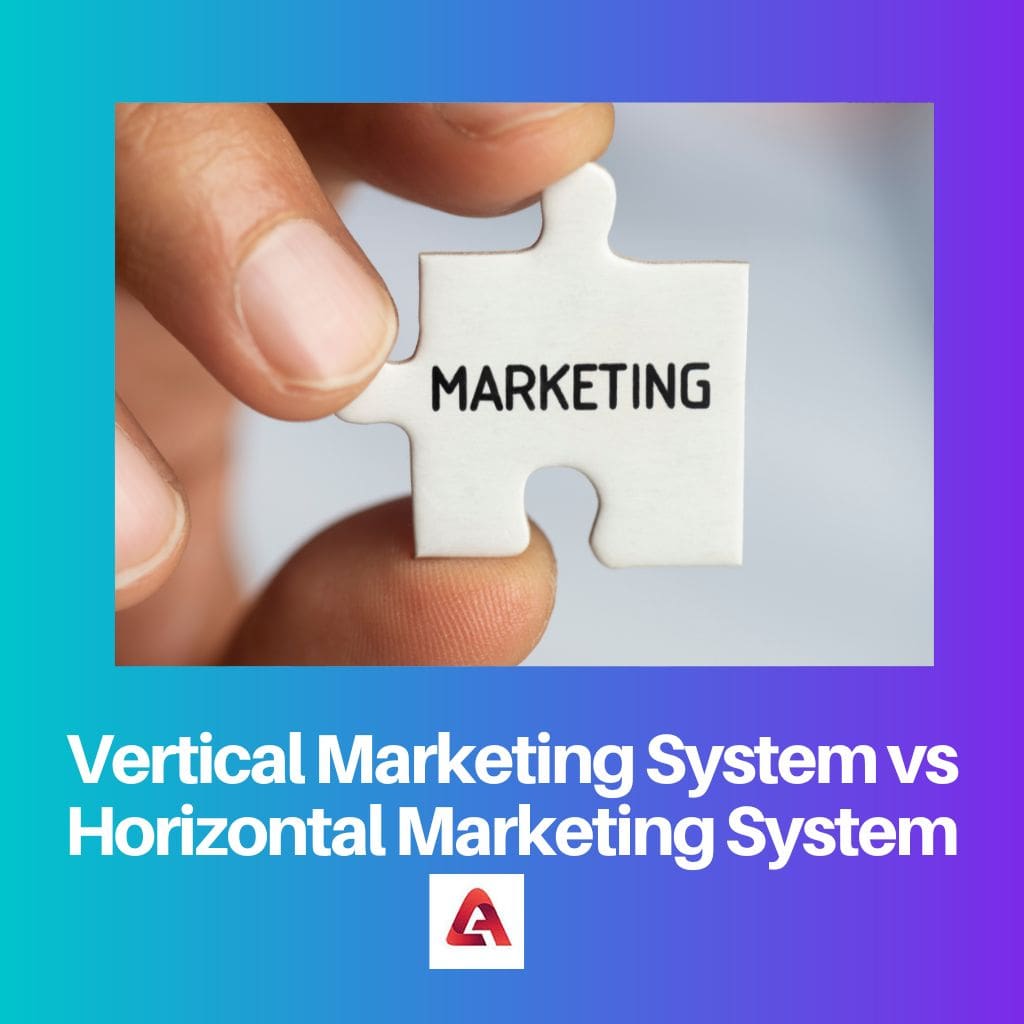Vertical marketing systems involve collaboration between different levels of the distribution channel (manufacturer, wholesaler, retailer) to achieve common goals, such as coordinated production and distribution. Horizontal marketing systems, on the other hand, involve cooperation between organizations at the same level of the distribution channel to leverage their collective resources and reach a wider audience, through strategic partnerships or alliances.
Key Takeaways
- In a vertical marketing system, producers, wholesalers, and retailers work together as a single unit to satisfy customer needs.
- In a horizontal marketing system, companies at the same distribution channel level, such as competing retailers, form alliances to increase their marketing power.
- A vertical marketing system can increase efficiency and reduce costs, while a horizontal marketing system can lead to increased market share and customer loyalty.
Vertical Marketing System vs. Horizontal Marketing System
Vertical marketing systems work together to improve efficiency and reduce costs by eliminating intermediaries. A horizontal marketing system is a distribution channel in which companies work together to meet the end consumer’s needs, bypassing traditional wholesalers and retailers.

A vertical marketing system is a type of marketing strategy where a team of people operates the businesses in the same industry. It comprises three components, i.e., manufacturer, wholesaler, and retailer. These three components work together to earn a significant profit.
A horizontal Marketing System is a marketing strategy where different businesses work on the same level. These various businesses join hands to produce the maximum profit. The horizontal system focuses on a greater audience.
Comparison Table
| Feature | Vertical Marketing System (VMS) | Horizontal Marketing System (HMS) |
|---|---|---|
| Target Audience | Specific industry or market segment (niche) | Broad audience across different industries or segments |
| Marketing Focus | Tailored messaging and content to specific needs and preferences | Universal message appealing to a diverse group |
| Collaboration | Limited, primarily within the vertical supply chain (manufacturer, wholesaler, retailer) | Open to collaboration with various companies at the same level (e.g., competitors for non-competing products) |
| Goal | Improve efficiency, reduce costs, enhance control over distribution | Expand market reach, pool resources, gain competitive advantage |
| Benefits | Deeper customer understanding, stronger relationships, brand reputation within the niche | Increased brand awareness, wider audience reach, economies of scale |
| Drawbacks | Limited reach, higher marketing costs, less flexibility | Potential brand dilution, competition with collaborators, difficulty in maintaining a consistent message |
| Examples | Luxury car dealerships, medical equipment suppliers, educational software for specific professions | Co-branded credit cards, joint marketing campaigns between non-competing grocery stores, sponsorship of sporting events featuring multiple brands |
What is Vertical Marketing System?
A Vertical Marketing System (VMS) refers to a distribution channel structure in which the members of the distribution channel, such as manufacturers, wholesalers, and retailers, work closely together to achieve efficient and effective distribution of products or services. This collaborative approach aims to streamline the flow of goods from production to consumption while maximizing efficiency and minimizing costs.
Components of a Vertical Marketing System
- Manufacturer Integration: In a VMS, manufacturers may choose to integrate vertically by owning and controlling various stages of the distribution process. This could involve owning distribution centers, establishing direct retail outlets, or even acquiring wholesalers. By integrating vertically, manufacturers have greater control over the distribution channel, ensuring consistent quality, pricing, and availability of their products.
- Wholesaler and Retailer Cooperation: Wholesalers and retailers play essential roles in a VMS by collaborating closely with manufacturers to ensure the smooth flow of products to end consumers. This collaboration involves sharing information on consumer demand, market trends, and inventory levels, allowing for more accurate forecasting and inventory management.
- Channel Coordination and Management: Effective coordination and management are crucial in a VMS to ensure that all members of the distribution channel are aligned with common goals and objectives. This may involve the use of technologies such as electronic data interchange (EDI) to facilitate communication and coordination between different channel partners. Additionally, the establishment of clear distribution agreements and performance metrics can help monitor and evaluate the effectiveness of the distribution channel.
- Consumer Focus: Ultimately, the primary focus of a VMS is to deliver value to consumers by providing them with convenient access to products or services. By aligning the efforts of all channel members towards meeting consumer needs and preferences, a VMS can enhance customer satisfaction and loyalty, leading to long-term success for all stakeholders involved.

What is Horizontal Marketing System?
A Horizontal Marketing System (HMS) refers to a strategic alliance or partnership between organizations at the same level of the distribution channel. Unlike traditional vertical structures where the focus is on the coordination between different levels of the channel, HMS emphasizes cooperation among entities that operate at the same level, such as manufacturers partnering with other manufacturers or retailers collaborating with other retailers.
Characteristics of a Horizontal Marketing System
- Strategic Alliances: In an HMS, organizations form strategic alliances or partnerships with other entities in the same industry to leverage their collective resources and capabilities. These alliances could take various forms, including joint ventures, cooperative advertising agreements, or co-branding initiatives. By pooling their strengths, organizations can enhance their market presence and competitiveness.
- Shared Resources and Expertise: Collaboration in an HMS enables organizations to share resources, such as distribution networks, marketing channels, or research and development capabilities. By tapping into each other’s expertise and strengths, partners can achieve economies of scale, reduce costs, and accelerate innovation. For example, two retailers might share warehousing facilities to lower operational expenses or collaborate on marketing campaigns to reach a broader audience.
- Market Expansion: One of the key objectives of an HMS is to expand market reach and penetration. By partnering with other organizations in the same industry, companies can access new markets or customer segments that they may not have been able to reach independently. This could involve entering new geographical regions, targeting niche markets, or expanding product offerings through complementary partnerships.
- Enhanced Competitive Advantage: Collaboration in an HMS can lead to a stronger competitive advantage for participating organizations. By combining their strengths and resources, partners can differentiate themselves from competitors, improve product offerings, and deliver greater value to customers. Additionally, alliances formed through an HMS can create barriers to entry for new competitors, thereby strengthening the market position of the collaborating entities.

Difference Between Vertical Marketing System and Horizontal Marketing System
- Structure:
- Vertical Marketing System (VMS): Involves collaboration between different levels of the distribution channel (manufacturer, wholesaler, retailer).
- Horizontal Marketing System (HMS): Involves cooperation among organizations at the same level of the distribution channel (e.g., manufacturer-to-manufacturer or retailer-to-retailer).
- Focus of Collaboration:
- VMS: Focuses on coordination between different levels of the distribution channel to achieve common goals such as efficient production and distribution.
- HMS: Emphasizes cooperation among entities operating at the same level of the distribution channel to leverage collective resources and capabilities.
- Integration vs Alliance:
- VMS: Often involves vertical integration where one member may own or control other levels of the distribution channel.
- HMS: Relies on horizontal alliances or partnerships between organizations at the same level of the distribution channel to achieve mutual benefits.
- Market Reach and Expansion:
- VMS: Typically focuses on optimizing distribution efficiency and reaching end consumers effectively.
- HMS: Aims to expand market reach by accessing new markets or customer segments through collaboration with partners.
- Competitive Advantage:
- VMS: Enhances competitive advantage through efficient coordination and control over the distribution channel.
- HMS: Strengthens competitive advantage by leveraging shared resources, expertise, and market reach through strategic alliances.




